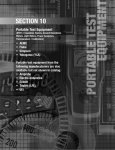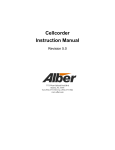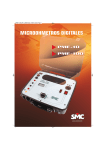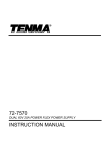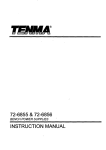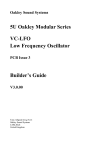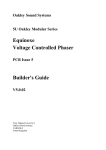Download 72-7400 INSTRUCTION MANUAL
Transcript
72-7400 PRECISION MILLI/MICRO OHMMETER INSTRUCTION MANUAL Tenma 72-7400 Instruction manual Table of Contents Introduction 2 Specification 3 EMC 4 Safety 5 Installation 6 Connections 7 Front Panel Controls 8 Operation 9 Maintenance 12 www.tenma.com 1 Tenma 72-7400 Instruction manual Introduction The 72-7400 is fully optimised for accurate measurement of low resistances with a best resolution of 1µΩ. It has applications beyond the testing of components such as measuring the resistance of motor or transformer windings, the properties of materials, the thickness of plates, the security of pipework joints or wiring installations and many others. It uses a Direct Current technique to measure true resistance, rather than the resistive component of impedance which is shown by AC excited RLC bridges. The test current for each range has been carefully chosen to minimise heating of the sample under test while being sufficient to minimise the effects of thermal emf and noise. This gives much greater accuracy at low resistances than can be obtained from the very low test currents used by general purpose high resolution multimeters. The low-noise low-drift bipolar amplifiers employed need much less noise filtering than alternative chopper stabilised technologies resulting in faster settling to the correct reading. The 72-7400 uses a four terminal measurement system and is supplied with a set of high quality Kelvin clip leads. For speed and convenience front panel switches are provided for current diversion (allowing in-situ zero adjustment) and current reversal (for identifying thermal emf effects). An indicator lamp confirms correct flow of the measuring current thus preventing spurious results from being recorded. The 72-7400 has eight push-button selected decade measurement ranges from 1999µΩ up to 19.99kΩ. A front panel operated ‘clamp’ switch is available to limit the maximum voltage across the unknown to 20mV. This is a requirement for the measurement of switch contact resistances to international standards. With a lowest range of 1999µΩ the 72-7400 can resolve 1µΩ. Precision analogue circuitry ensures high measurement accuracy of up to 0.1% of reading ±1 digit. The 72-7400 is a fully portable instrument which operates from NiMH rechargeable batteries. Stabilised internal operating conditions ensure that readings do not vary with the state of the battery charge. The battery charger is built into the instrument and can be operated while measurements continue. 2 www.tenma.com Tenma 72-7400 Instruction manual Specification Ranges and Accuracy The 3½ digit display has a 1999 count full scale. Eight ranges are provided: Range Resolution Test Current F.S. voltage Accuracy 1999 µΩ 1 µΩ 250 mA 500 µV 0.1% reading + 0.4% range 19.99 mΩ 10 µΩ 50 mA 1 mV 0.1% reading + 0.2% range 199.9 mΩ 100 µΩ 10 mA 2 mV 0.1% reading + 0.1% range 1999 mΩ 1 mΩ 5 mA 10 mV 0.1% reading + 0.1% range 19.99 Ω 10 mΩ 500 µA 10 mV 0.1% reading + 0.1% range 199.9 Ω 100 mΩ 50 µA 10 mV 0.1% reading + 0.1% range 1999 Ω 1Ω 10 µA 100 mV 0.1% reading + 0.1% range 19.99 kΩ 10 Ω 10 µA 200 mV 0.1% reading + 0.2% range Accuracies apply for a calibration interval of 1 year at 23º ±5ºC after 5 minutes warm-up, with the instrument and test connections in thermal equilibrium and the zero correctly set. Temperature coefficient outside the stated range is < ±45 ppm/ºC. Facilities Set zero by front panel control with switch to divert test current from unknown. Test current polarity reversal for thermal emf detection. Front panel lamp indicates correct force circuit measurement conditions. 20mV source emf clamp to limit open circuit voltage across the unknown to 20mV maximum for "dry circuit" testing of switch and relay contacts. (Not available on 2kΩ and 20kΩ ranges.) Built-in battery charger allows instrument operation while re-charging. Measurement circuit Source emf: 18 mV (±2mV) with clamp active, < 6 V otherwise. Compliance: > 0.5 V on 1999µΩ range, > 1.0 V on all other ranges. Protection: The meter is protected against the back-emf of its own test current from any inductance and against accidental short-term connection to external voltage sources up to 50 V. General Battery: 4 internal non-removable Ni-MH cells. Low battery indication in display. Operating time: Typically > 150 hours with no test current flowing, > 8 hours continuous measurement on lowest range. Power: 110V–120V or 220V–240V AC (internal setting) ±10%, 50/60 Hz, 20VA max. Recharge time: Nominally 12 hours with instrument not in use. Operating Range: Indoor use +5ºC to +40ºC, 20% to 80% RH, up to 2000m, Pollution Degree 1. Storage Range: −40ºC to +50ºC. Safety and EMC: Complies with EN61010–1 (safety) and EN61326 (EMC). Size and Weight: 220 mm (w) x 102 mm (h) x 235 mm (d), 1.5 kg. Accessories: Supplied with Kelvin clip leads. www.tenma.com 3 Tenma 72-7400 Instruction manual EMC This Tenma 72-7400 has been designed to meet the requirements of the EMC Directive 89/336/EEC. Compliance was demonstrated by meeting the test limits of the following standards: Emissions EN61326 (1998) EMC product standard for Electrical Equipment for Measurement, Control and Laboratory Use. Test limits used were: a) b) c) Radiated: Class B Conducted: Class B Harmonics: EN61000-3-2 (2000) Class A; the instrument is Class A by product category. Immunity EN61326 (1998) EMC product standard for Electrical Equipment for Measurement, Control and Laboratory Use. Test methods, limits and performance achieved were: a) EN61000-4-2 (1995) Electrostatic Discharge : 4kV air, 4kV contact, Performance A. b) EN61000-4-3 (1997) Electromagnetic Field, 3V/m, 80% AM at 1kHz, Performance B. c) EN61000-4-11 (1994) Voltage Interrupt, 1 cycle, 100%, Performance A. d) EN61000-4-4 (1995) Fast Transient, 1kV peak (AC line), 0.5kV peak (measurement inputs), Performance A. e) EN61000-4-5 (1995) Surge, 0.5kV (line to line), 1kV (line to ground), Performance A. f) EN61000-4-6 (1996) Conducted RF, 3V, 80% AM at 1kHz, AC line, Performance A. According to EN61326 the definitions of performance criteria are: Performance criterion A: ‘During test normal performance within the specification limits.’ Performance criterion B: ‘During test, temporary degradation, or loss of function or performance which is self-recovering’. Performance criterion C: ‘During test, temporary degradation, or loss of function or performance which requires operator intervention or system reset occurs.’ Cautions To ensure continued compliance with the EMC directive the following precautions should be observed: a) after opening the case for any reason ensure that all signal and ground connections are remade correctly before replacing the cover. Always ensure all case screws are correctly refitted and tightened. b) In the event of part replacement becoming necessary, only use components of an identical type, see the Service Manual. 4 www.tenma.com Tenma 72-7400 Instruction manual Safety This instrument is Safety Class I according to IEC classification and has been designed to meet the requirements of EN61010−1 (Safety Requirements for Electrical Equipment for Measurement, Control and Laboratory Use). It is an Installation Category II instrument intended for operation from a normal single phase supply. This instrument has been tested in accordance with EN61010−1 and has been supplied in a safe condition. This instruction manual contains some information and warnings which have to be followed by the user to ensure safe operation and to retain the instrument in a safe condition. This instrument has been designed for indoor use in a Pollution Degree 2 environment in the temperature range 5°C to 40°C, 20% −80% RH (non−condensing). It may occasionally be subjected to temperatures between +5° and −10°C without degradation of its safety. Do not operate while condensation is present. Use of this instrument in a manner not specified by these instructions may impair the safety protection provided. Do not operate the instrument outside its rated supply voltages or environmental range. WARNING! THIS INSTRUMENT MUST BE EARTHED Any interruption of the mains earth conductor inside or outside the instrument will make the instrument dangerous. Intentional interruption is prohibited. The protective action must not be negated by the use of an extension cord without a protective conductor. When the instrument is connected to its supply, terminals may be live and opening the covers or removal of parts (except those to which access can be gained by hand) is likely to expose live parts. The apparatus shall be disconnected from all voltage sources before it is opened for any adjustment, replacement, maintenance or repair. Any adjustment, maintenance and repair of the opened instrument under voltage shall be avoided as far as possible and, if inevitable, shall be carried out only by a skilled person who is aware of the hazard involved. If the instrument is clearly defective, has been subject to mechanical damage, excessive moisture or chemical corrosion the safety protection may be impaired and the apparatus should be withdrawn from use and returned for checking and repair. The instrument contains both non-resetting and self-resetting thermal fuses which are not replaceable by the user. The short-circuiting of these protective devices is prohibited. The instrument contains Nickel Metal Hydride batteries. Do not open, puncture, incinerate or short circuit these cells. These batteries must be disposed of in accordance with local regulations and should be removed from the instrument before its final disposal. Do not wet the instrument when cleaning it. The following symbols are used on the instrument and in this manual:− Caution −refer to the accompanying documentation, incorrect operation may damage the instrument. Alternating current. www.tenma.com 5 Tenma 72-7400 Instruction manual Installation Mains Operating Voltage The operating voltage of the instrument is shown on the rear panel. Should it be necessary to change the operating voltage from 115V to 230V or vice-versa, proceed as follows: 1. Disconnect the instrument from all voltage sources. 2. Remove the screws which hold the case upper to the case lower and lift off. 3. Disconnect the 3 way cable from the power supply PCB, remove the six screws and lift the PCB from the case. (The Power Supply PCB has an insulator attached to its underside to ensure that the batteries are not accidentally short circuited. The centre pin of the retaining rivets can be carefully pushed out allowing them to be re-used. Replace the insulator immediately after servicing is complete.) 4. Fit the soldered links for the required operating voltage:For 115V fit LK1 and LK3 and not LK2 For 230V fit only LK2 These links may be either tinned copper wire or zero-ohm resistors. 5. Refit the power supply PCB to the case lower and reconnect the 3 way cable. 6. Refit the case upper taking care not to overtighten the screws. 7. To comply with safety standard requirements the operating voltage marked on the rear panel must be changed to clearly show the new voltage setting. Fuses There are no user replaceable fuses in the instrument. Mains Lead When a three core mains lead with bare ends is provided it should be connected as follows: Brown - Mains live Blue - Mains Neutral Green/Yellow - Earth WARNING! THIS INSTRUMENT MUST BE EARTHED Any interruption of the mains earth conductor inside or outside the instrument will make the instrument dangerous. Intentional interruption is prohibited. 6 www.tenma.com Tenma 72-7400 Instruction manual Connections Input Terminals Connections are provided on the front panel for standard 4-terminal resistance measurements. The test current flows between the terminals marked FORCE + and – and the voltage across the unknown resistance is measured between the terminals marked SENSE + and –. To obtain correct readings the entire measurement circuit should be connected only to the resistance being measured. The instrument is supplied with a Kelvin lead set consisting of two special crocodile clips connected to four 4mm plugs. The upper and lower jaws of each crocodile clip are not electrically connected: the grey jaws are used as the force terminals and the colored jaws (red and black) as the sense terminals. The grey jaws are connected to the plugs which have a grey collar. Connect these leads to the instrument as follows: Plug Connection All red Sense + Red with grey collar Force + All black Sense – Black with grey collar Force – The instrument can be used with any other 4 terminal connection arrangement as required by the physical size of the resistance being measured. The measurement circuit is not grounded (even when the battery is charging) but for the safety of the operator the connections should be within ±30 volts from earth. It is permissible for the circuit to be externally connected to earth at one point only. The maximum voltage emitted from the instrument is 6V DC. Protection When measuring the resistance of large iron-cored inductors the test current builds a magnetic field within the core. When this current is removed a back-emf is generated as the field collapses. Take care when disconnecting the test leads from inductors not to touch the terminals as the back-emf can give a noticeable electric shock. It is better to depress the Set Zero switch and allow the instrument to absorb the stored energy before disconnecting the inductor. Protection circuits within the instrument ensure that it will not be damaged by the back-emf of its own test current from any inductance. It is not intended that any external voltage be applied to the input terminals. However, there are circuits designed to protect the instrument against brief accidental connections. In the case of more severe misuse fusible resistors protect the internal circuits. These resistors are not replaceable by the user. www.tenma.com 7 Tenma 72-7400 Instruction manual Front Panel Controls The following paragraphs give a brief description of the controls. Fuller details of the operation of the instrument are given in later sections. Operate The Operate switch connects the measurement circuits to the battery; it does not control the battery charger which operates whenever the unit is connected to the supply mains. Set Zero Depressing the Set Zero switch diverts the test current away from the Force terminals so there is no voltage drop across the resistance being measured. The reading can then be set to zero taking account of the effect of external thermal emfs. 20mV Clamp Depressing the 20mV Clamp switch limits the open circuit voltage of the force terminals to 20mV. This is used when measuring the contact resistance of switches or relays as this low voltage does not break down oxide films. Polarity Depressing the Polarity switch reverses the direction of the test current through the unknown. If there are no thermal emfs in the measurement circuit the two readings should be the same (apart from the minus sign). If a thermal emf is present it will add to one reading and subtract from the other; the true resistance value is obtained by taking the numerical average. Range switches The legend above the range switches shows the display units (µΩ, mΩ, Ω or kΩ). The nominal measurement current is shown below the switches for reference. Charge lamp (red) The Charge lamp will light while the unit is connected to the mains supply which causes the battery to be charged. The unit should be disconnected from the supply when the battery is fully charged. Force On lamp (green) The Force On lamp lights when the test current is flowing correctly. If the 20mV clamp is in use the lamp will only light when the external voltage drop is less than the clamp threshold. Display The 3½ digit display shows the measurement result. It should only be taken as valid when the Force On lamp is lit and the BAT indicator is off. When the resistance is too large for the range selected (or the sense leads are open circuit) the overscale indication consists of a 1 and three blank digits. A negative sign will show when reverse polarity readings are being taken. The zero setting is signed; the display will alternate between –000 and +000 at true zero. The signal BAT in the lower left corner of the display shows when the battery is nearly discharged. At this point readings are still accurate, but there is no further indication when the battery voltage falls to the point that errors arise; therefore when the BAT indication is displayed the charger should be connected to the supply. 8 www.tenma.com Tenma 72-7400 Instruction manual Operation Switching On Switch on the instrument using the Operate switch on the front panel. If there are no digits shown in the display then the batteries may be completely discharged. Connect the unit to the supply mains; the Charge lamp should light to show that charging is taking place. If display operation does not resume after a few minutes charging time the unit may be faulty; switch off, disconnect from the supply and seek service. Battery Charging When the unit is connected to the supply mains the red Charge lamp will be illuminated and the battery will be charging. Resistance measurements may continue while charging with some small reduction in accuracy because of the temperature rise within the unit. Charging normally takes about 12 hours but if the 2000µΩ range is used the 250mA test current considerably reduces the charging current and it will take longer to fully charge the battery. A taper charge characteristic is employed to quickly raise the charge level of a completely discharged battery and reduce the current once fully charged; nevertheless, the unit should not be left on continuous float charge as this will reduce battery life. The Ni-MH cells used do not suffer from any memory effect and are not harmed by either complete discharge or partial re-charge. While the unit is not in use the batteries will self-discharge. This effect is greatly increased at higher temperatures. If the unit has been stored for so long that the batteries have become completely discharged it may require two or three charge–discharge cycles for full capacity to be restored. The batteries are not replaceable by the user. If the capacity becomes noticeably low then the unit should be sent to a qualified service facility for the batteries to be replaced. The cells must be handled and disposed of in accordance with local safety and environmental requirements. Principles of Operation This instrument measures resistance using the ratiometric method: a test current is passed through both a precise internal reference resistance and the unknown resistance. The magnitude of the test current is chosen according to the range selected; it is a compromise between sensitivity to noise and thermal emfs and minimising self-heating of the unknown. The voltages developed across the two resistances are compared using a ratiometric Analogue to Digital converter which calculates the result for the display. The accuracy of this method depends on the accuracy of the reference resistors and on sensing the exact voltage drop across the unknown, not on the magnitude of the test current. The two main sources of error are voltage drops in the connections and thermal emfs. The problem of voltage drops is overcome by the 4 terminal connection. The current flows in the force leads and the instrument can tolerate any voltage drop in these leads up to its compliance limit. There is no voltage drop in the sense leads because of the very high input impedance of the voltage measuring circuit in the unit. The resistance is measured between the physical points where the sense leads connect to the unknown. An emf is produced at any junction between dissimilar metals. The magnitude of this emf depends on the materials and the temperature. In any closed circuit which starts and ends on the same metal (as in the sockets of the instrument) there will be a equal number of junctions between dissimilar metals. If all the pairs of junctions are at the same temperature then the net emf around the circuit is zero, but if there are temperature differences then the sum of the emfs is not zero - this difference is the thermal emf of the circuit. It is often of the order of a few tens of microvolts which is sufficient to influence the reading on low resistance ranges. The instrument cannot distinguish between this emf and the voltage drop across the test sample caused by the measuring current. However if the direction of the test current is reversed then the thermal emf will add to one reading and subtract from the other; the true resistance can be calculated as the average of the two readings. This is the purpose of the Polarity switch. www.tenma.com 9 Tenma 72-7400 Instruction manual The most effective way to remove thermal emfs is by removing the temperature differences; take care when connecting samples not to hold the connections points in the fingers - do not touch plug contacts when connecting the leads. Wait until thermal equilibrium is established - it can take many minutes for the effect of even the most brief contact with the fingers to dissipate. The effect of thermal emfs could also be eliminated by the use of an AC measurement technique but this results in measuring the resistive component of impedance (including the effect of any core losses etc.) rather than the true resistance value obtained by the DC method used in this instrument. Setting Zero To set the zero reading it is necessary that the force current is flowing (so the reference resistance is experiencing normal conditions) and that there is no voltage between the sense terminals. The ZERO ADJUST control can then be set for a reading of zero to compensate for the internal offset voltages of the instrument. The most direct way to do this is to use one cable to connect FORCE + to FORCE – and a second cable to join SENSE + to SENSE –, select the range required and use the ZERO ADJUST control to obtain a reading of zero. Note that this reading is signed: the exact zero is at the point where the minus sign in the display appears on alternate readings. These cables are then removed and the test sample connected as required. This method zeros the internal offsets within the instrument. The zero adjustment can also be used to remove the effect of small external thermal emfs from the measurement. Connect the test cables to the unknown ready to take a measurement and select the required range. Depress the Set Zero button and set the reading to zero. Release the Set Zero button and allow the reading to settle at the resistance value. This is the most convenient method in normal use. Note that the zero cannot be set with the sense terminals open circuit. Connecting the Unknown Resistance The Kelvin clips supplied with the instrument make the force and sense connections on opposite sides of the conductor. This suits wire-ended components and long thin objects. When measuring low resistance physically large samples, separate wires and clips may be needed for the two sets of connections which must be made in a way that reflects the required measurement. The sense terminals should be connected to the sample at the exact points between which the resistance is to be measured; the force terminals should be connected to the sample outside the sense terminals. They should be sufficiently far from the sense connections to allow for the region where the current spreads out across the cross-section of the sample. When measuring components the test connections should match the application connections as closely as possible; when measuring the properties of material samples, consistency of connection is the most important thing. This may require the construction of a suitable jig. The green Force On lamp lights when the test current flowing through the unknown produces a voltage drop within the compliance specification of the instrument. A valid reading can then be obtained provided that the sense connections are properly made (if they are not then the display will normally show the overrange indication). Note that when measuring very large inductances (such as high voltage transformers) there may be a delay before the lamp lights as it takes some time for the test current to rise to the full value (the rate of rise of the current depends on the inductance and the source emf of the instrument). Similarly it takes time for the current to reverse when the Polarity selection is switched. It is very important when attaching connections to avoid touching any metallic part of the circuit, because the heat conducted from the fingers will generate thermal emfs that take a significant time to decay. 10 www.tenma.com Tenma 72-7400 Instruction manual Taking the Reading After setting zero, release the Set Zero switch and allow the reading to settle at the resistance value. Note this reading and depress the Polarity switch; ideally (if there are no external thermal emfs) this reading will be the same as the first. If it is not, take the numerical average of the two (ignore the sign); this value is the true resistance. Note that if the sample is not in thermal equilibrium the reading will be changing because of both thermal emfs and the temperature coefficient of the unknown. It is possible to check the results by depressing the Set Zero button, noting the zero reading and then computing the two differences between this value and the reading of each polarity (taking the signs into account). These two values should agree within a digit; if they do not, then the thermal emfs are changing too rapidly for a reliable measurement to be made. Contact Resistance Measurements The contacts of relays, switches etc. are often covered by oxides or corrosion products. If the voltage in the circuit being switched is not high enough to break down this insulating film the contact resistance measured will be much higher than that measured in a high power conditions. In order to obtain a reading that reflects the operation of the component in these “dry circuit” conditions it is necessary to ensure that the test equipment does not subject the sample to a high open circuit voltage. International standards define the “dry circuit” measurement voltage as being not more than 20mV. This instrument contains a suitable clamp circuit activated by the front panel 20mV Clamp push button. This places an internal electronic shunt across the force terminals and controls the resistance of this circuit to maintain a voltage of 18mV (±2mV) between these terminals. When the contact being measured closes, its resistance must be sufficiently low for the voltage drop across it (at the measuring current of the range selected) to be less than the clamp voltage. The internal shunt then switches off, the green Force On lamp lights and the correct resistance reading is displayed. Note that battery drain is higher when the clamp is engaged as the measurement current is always flowing, either through the internal clamp or the external contact. The 20mV clamp facility does not operate with the 2kΩ or 20kΩ ranges as the maximum measurement voltage on these ranges is greater than 20mV. Applications To measure the temperature rise of the windings of a transformer or motor first measure the resistance with the item cold. Then disconnect the meter and operate the device for the required period of time. Disconnect all supplies and re-connect the meter and measure the winding resistance in the hot condition. Knowing the temperature coefficient of the winding material these two resistance readings can be used to calculate the temperature change. Measurement Notes If the reading drifts continuously this may indicate either a change in a thermal emf caused by a change in temperature or a real change in the resistance of the item being measured. If the sample is physically small this may be caused by the heating effect of the test current. Using a higher range reduces the test current but also reduces the measurement resolution. Random fluctuations in the reading of more than a digit may indicate poor connections to the sample under test, particularly the sense leads. It can also be caused by magnetic fields intersecting the test circuit; move the leads to keep them close together and away from any transformers or motors. If the three readings (zero, normal and reverse polarity) do not correlate then either there is a poor connection, or a thermal emf is changing rapidly or the actual value being measured is changing rapidly. Semiconductor junctions will appear open circuit in both directions because the measurement voltage of this instrument is too small to cause any noticeable conduction. www.tenma.com 11 Tenma 72-7400 Instruction manual Maintenance For service repair and calibration please contact your local Tenma distributor or go to www.tenma.com Cleaning If the instrument requires cleaning use a cloth that is only lightly dampened with water or a mild detergent. WARNING! TO AVOID ELECTRIC SHOCK, OR DAMAGE TO THE INSTRUMENT, NEVER ALLOW WATER TO GET INSIDE THE CASE. TO AVOID DAMAGE TO THE CASE NEVER CLEAN WITH SOLVENTS. Calibration To ensure that the accuracy of the instrument remains within specification the calibration must be checked (and if necessary adjusted) annually. This requires access to accurately known standard resistors; the instrument is adjusted to obtain the correct readings from these resistors. This instrument has independent calibration for each range. Fuses The transformer primary is protected by a non-resetting thermal fuse inside the windings. It can only be replaced by fitting a new transformer. The battery charge and discharge circuits are protected by self-resetting devices. If it is suspected that one of these has tripped, disconnect the unit from the mains supply, switch it off and wait ten minutes. It is likely that any such tripping indicates an internal fault and the unit should be serviced by a competent repair facility. 12 www.tenma.com TEST EQUIPMENT 405 Pioneer Blvd. Springboro, Ohio 45066 Book Part No. 48581-1340 Issue 1















